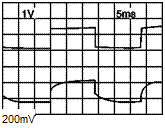Dynamic balancing
The overall time constant of the anemometer may be calculated by theoretical considerations; in practical applications, however, the
Response of a CCA to a square wave test at two different speeds of the stream
![]()
 |
![]() V = 0
V = 0
configuration of the probe introduces so many and uncontrollable parameters as to make unreliable the value of tw calculated. On the other hand, to perform even in this case a calibration, one should have either a sample turbulence or make the probe oscillate with the desired frequency in a flow with a constant speed. It is therefore necessary to use indirect methods.
The most accepted method is to send a square wave voltage signal in the wire (in all the commercial anemometers, a square wave generator is provided), which simulates a similar variation of speed, and displays the response of the wire on an oscilloscope at various flow speeds (Figure 3.12). Acting on the circuit components (resistors, overheating ratio, gain of the amplifier), the frequency response of the anemometer can be optimized.
The biggest flaw in the constant current system is the fact that the frequency response of the sensor depends not only on the characteristics of the sensor but also on the characteristics of the fluid stream: the answer depends, as we have seen, both on the heat capacity of the wire and on the coefficient of heat exchange between sensor and environment. In particular, since the sensor response changes with fluid speed, the frequency compensation of the amplifier should be readjusted at every change in the average speed. This is not practical and therefore the anemometer at constant current is used only in cases where the average speed remains constant (steady turbulence).












